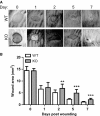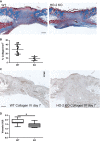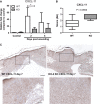Delayed cutaneous wound closure in HO-2 deficient mice despite normal HO-1 expression
- PMID: 25224969
- PMCID: PMC4302653
- DOI: 10.1111/jcmm.12389
Delayed cutaneous wound closure in HO-2 deficient mice despite normal HO-1 expression
Abstract
Impaired wound healing can lead to scarring, and aesthetical and functional problems. The cytoprotective haem oxygenase (HO) enzymes degrade haem into iron, biliverdin and carbon monoxide. HO-1 deficient mice suffer from chronic inflammatory stress and delayed cutaneous wound healing, while corneal wound healing in HO-2 deficient mice is impaired with exorbitant inflammation and absence of HO-1 expression. This study addresses the role of HO-2 in cutaneous excisional wound healing using HO-2 knockout (KO) mice. Here, we show that HO-2 deficiency also delays cutaneous wound closure compared to WT controls. In addition, we detected reduced collagen deposition and vessel density in the wounds of HO-2 KO mice compared to WT controls. Surprisingly, wound closure in HO-2 KO mice was accompanied by an inflammatory response comparable to WT mice. HO-1 induction in HO-2 deficient skin was also similar to WT controls and may explain this protection against exaggerated cutaneous inflammation but not the delayed wound closure. Proliferation and myofibroblast differentiation were similar in both two genotypes. Next, we screened for candidate genes to explain the observed delayed wound closure, and detected delayed gene and protein expression profiles of the chemokine (C-X-C) ligand-11 (CXCL-11) in wounds of HO-2 KO mice. Abnormal regulation of CXCL-11 has been linked to delayed wound healing and disturbed angiogenesis. However, whether aberrant CXCL-11 expression in HO-2 KO mice is caused by or is causing delayed wound healing needs to be further investigated.
Keywords: haem oxygenase; skin; wound healing.
© 2014 The Authors. Journal of Cellular and Molecular Medicine published by John Wiley & Sons Ltd and Foundation for Cellular and Molecular Medicine.
Figures






Similar articles
-
Effects of Remote Ischemic Preconditioning on Heme Oxygenase-1 Expression and Cutaneous Wound Repair.Int J Mol Sci. 2017 Feb 17;18(2):438. doi: 10.3390/ijms18020438. Int J Mol Sci. 2017. PMID: 28218659 Free PMC article.
-
Heme oxygenase-2 deletion impairs macrophage function: implication in wound healing.FASEB J. 2015 Jan;29(1):105-15. doi: 10.1096/fj.14-256503. Epub 2014 Oct 23. FASEB J. 2015. PMID: 25342128 Free PMC article.
-
The role of neutrophils in corneal wound healing in HO-2 null mice.PLoS One. 2011;6(6):e21180. doi: 10.1371/journal.pone.0021180. Epub 2011 Jun 17. PLoS One. 2011. PMID: 21695050 Free PMC article.
-
Heme Oxygenase-1 as Therapeutic Target for Diabetic Foot Ulcers.Int J Mol Sci. 2022 Oct 10;23(19):12043. doi: 10.3390/ijms231912043. Int J Mol Sci. 2022. PMID: 36233341 Free PMC article. Review.
-
The heme oxygenase-carbon monoxide system: regulation and role in stress response and organ failure.Intensive Care Med. 2008 Apr;34(4):640-8. doi: 10.1007/s00134-008-1010-2. Epub 2008 Feb 20. Intensive Care Med. 2008. PMID: 18286266 Review.
Cited by
-
Heme Oxygenases in Cardiovascular Health and Disease.Physiol Rev. 2016 Oct;96(4):1449-508. doi: 10.1152/physrev.00003.2016. Physiol Rev. 2016. PMID: 27604527 Free PMC article. Review.
-
Dysregulation of Iron Metabolism-Linked Genes at Myocardial Tissue and Cell Levels in Dilated Cardiomyopathy.Int J Mol Sci. 2023 Feb 2;24(3):2887. doi: 10.3390/ijms24032887. Int J Mol Sci. 2023. PMID: 36769209 Free PMC article.
-
CXCL12-CXCR4 Interplay Facilitates Palatal Osteogenesis in Mice.Front Cell Dev Biol. 2020 Aug 21;8:771. doi: 10.3389/fcell.2020.00771. eCollection 2020. Front Cell Dev Biol. 2020. PMID: 32974338 Free PMC article.
-
Effects of Remote Ischemic Preconditioning on Heme Oxygenase-1 Expression and Cutaneous Wound Repair.Int J Mol Sci. 2017 Feb 17;18(2):438. doi: 10.3390/ijms18020438. Int J Mol Sci. 2017. PMID: 28218659 Free PMC article.
-
Heme Oxgenase-1, a Cardinal Modulator of Regulated Cell Death and Inflammation.Cells. 2021 Feb 28;10(3):515. doi: 10.3390/cells10030515. Cells. 2021. PMID: 33671004 Free PMC article. Review.
References
-
- Martin P. Wound healing–aiming for perfect skin regeneration. Science. 1997;276:75–81. - PubMed
-
- Sidgwick GP, Bayat A. Extracellular matrix molecules implicated in hypertrophic and keloid scarring. J Eur Acad Dermatol Venereol. 2012;26:141–52. - PubMed
-
- Otterbein LE, Choi AM. Heme oxygenase: colors of defense against cellular stress. Am J Physiol Lung Cell Mol Physiol. 2000;279:L1029–37. - PubMed
Publication types
MeSH terms
Substances
Grants and funding
LinkOut - more resources
Full Text Sources
Other Literature Sources
Research Materials

